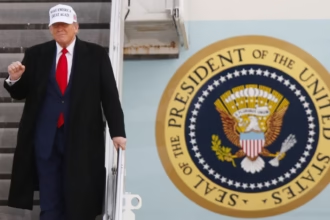U.S. dollar bill.
Catherine Mcqueen | Moment | Getty Images
Asia is progressively moving away from the U.S. dollar, as a mix of geopolitical uncertainties, monetary shifts and currency hedging prompt de-dollarization across the region.
Recently, the Association of Southeast Asian Nations, or ASEAN, committed to boosting the use of local currencies in trade and investment as part of its newly released Economic Community Strategic Plan for 2026 to 2030. The plan outlined efforts to reduce shocks associated with exchange rate fluctuations by promoting local currency settlements and strengthening regional payment connectivity.
“Trump’s erratic trade policy decisions and the dollar’s sharp depreciation are probably encouraging a more rapid shift towards other currencies,” said Francesco Pesole, FX strategist at ING.
While the shift is more pronounced in Asia, the world has also been cutting its reliance on the greenback, with the share of the dollar in global foreign exchange reserves declining from over 70% in 2000 to 57.8% in 2024. More recently, the greenback also saw a steep selloff this year, particularly in April, following uncertainty around U.S. policymaking. Since the start of the year, the dollar index has weakened by over 8%.
While de-dollarization is not exactly a new phenomenon, the narrative has changed. Investors and officials are beginning to recognize that the dollar can and has been used as a leverage — if not overtly weaponized — in trade negotiations. This has led to a reevaluation of predominantly overweight U.S. dollar portfolios, said Mitul Kotecha, Barclays’ head of FX and EM macro strategy in Asia.
“Countries are looking at the fact that the dollar has been, and can be used as a sort of weapon on trade, direct sanctions, etc… That’s been the real change, I think, in the last several months,” he told CNBC.
De-dollarization is growing as Asian economies in particular seek to reduce reliance on the greenback in hopes of using their own currencies as a medium of exchange to reduce FX risks, said Lin Li, head of global markets research for Asia at MUFG.
Picking up pace
The move away from the dollar is gaining momentum in ASEAN, driven mainly by two forces: people and companies gradually converting their U.S. dollar savings back into local currencies, and large investors hedging foreign investments more actively, according to a recent note by Bank of America.
“De-dollarization in ASEAN is likely to pick up pace, primarily via conversion of FX deposits accumulated since 2022,” the bank’s Asia fixed income and FX strategist Abhay Gupta said.
Beyond ASEAN, the BRICS nations, which include India and China, have also actively developed and peddled their own payment system to bypass traditional systems like SWIFT and reduce dependency on the dollar. China has also been promoting bilateral trade settlements in the yuan.
Countries are looking at the fact that the dollar has been, and can be used as a sort of weapon on trade, direct sanctions, etc… That’s been the real change.
De-dollarization is an “ongoing, slow process,” said Barclays’ Kotecha. “[But] you can see it from central bank reserves, which have been gradually reducing the dollar share. You could see that from the share of the dollar in trade transactions,” he told CNBC. He added that Asian economies such as Singapore, South Korea, Taiwan, Hong Kong and China own a large share of foreign assets, giving them the greatest potential to repatriate their foreign earnings or assets back to their home currencies.
The sentiment is echoed by ITC Markets’ Asian FX and rates analyst Andy Ji, who noted that economies most reliant on trade will experience more significant declines in U.S. dollar demand, singling out the ASEAN+3 nations, which include China, Japan, South Korea, alongside the 10 ASEAN member states. As of last November, ASEAN+3 has over 80% of trade invoices in U.S. dollars.
De-dollarization is also occurring as Asian investors increasingly hedge their U.S. dollar exposures, according to Nomura. FX hedging is when an investor protects themselves from big swings in currency values by locking in exchange rates to avoid losses if the U.S. dollar weakens or strengthens unexpectedly.
When investors hedge their exposure to the dollar, they sell the greenback and buy local or alternative currencies, which increases demand for and appreciates the latter against the dollar.

“Some of the high performers that we’re looking at will be places like Japanese yen, Korean won and Taiwan dollar,” said Craig Chan, global head of FX strategy at Nomura Securities, who has observed a fair bulk of FX hedging coming from institutional investors like life insurance companies, pension funds and hedge funds.
The hedge ratio for Japanese life insurers is about 44%, according to Nomura. Based on the financial holding company’s estimates, that figure increased to around 48% in April and May. For Taiwan, Nomura estimates a hedge ratio of about 70%.
Dollar still king?
The shift away from the dollar also begs the question of whether this is a temporary phase or a structural shift.
For now, it may still just be cyclical, said Cedric Chehab, chief economist at BMI, who noted that it will only be structural if the U.S. employs sanctions more aggressively, making central banks wary of holding too many dollars. A second scenario would be if governments mandate their pension funds to invest a larger share of their assets domestically.
While some countries are reducing their exposure and reliance on the dollar, it remains challenging to dethrone the greenback’s position as the number one reserve currency, said industry watchers.
“No other currency holds the same liquidity, depth of bond and credit market as the dollar, so it’s more a matter of a reduction in its reserve appeal, rather than losing its throne,” said Pescole.
It’s also important to distinguish between U.S. dollar weakness from de-dollarization, said Peter Kinsella, global head of Forex strategy at Union Bancaire Privée.
“We’ve seen the U.S. dollar weaken before over various cycles and regimes – but it always maintained its reserve and hegemonic status,” said Kinsella, who added that the greenback’s use in trade and invoicing remains paramount in spite of the reduction in U.S. dollar exposure. As of April this year, more than half of global trade is still invoiced in dollar terms.
“That said, the wider decline in the USD’s use as a reserve asset appears set to continue, and I strongly expect that gold will be the main beneficiary from this,” said the strategist.








